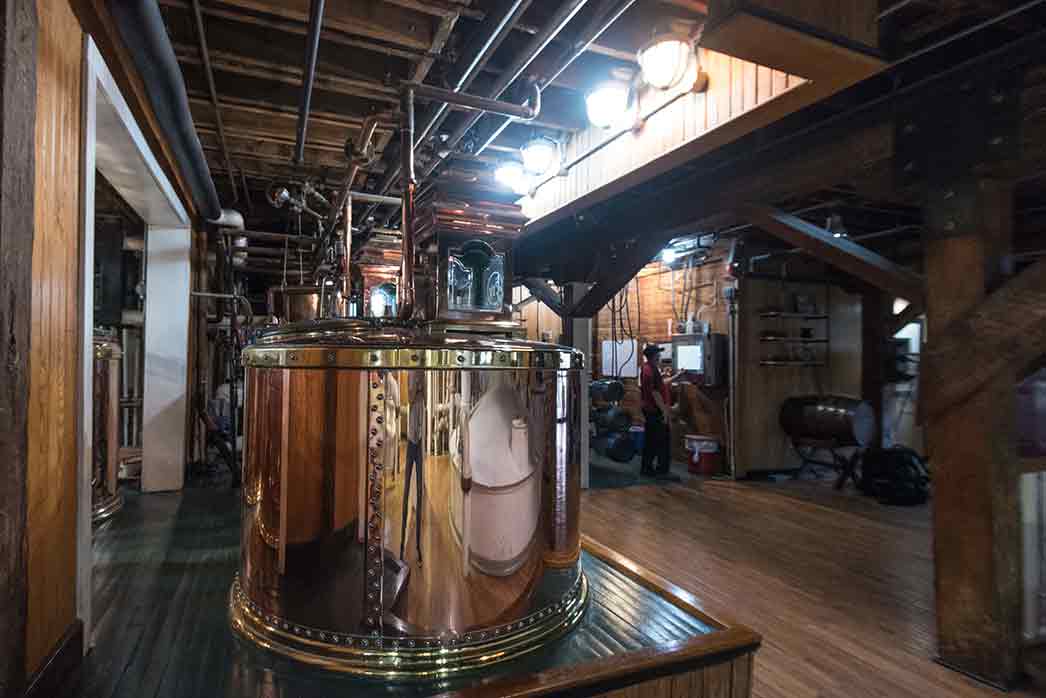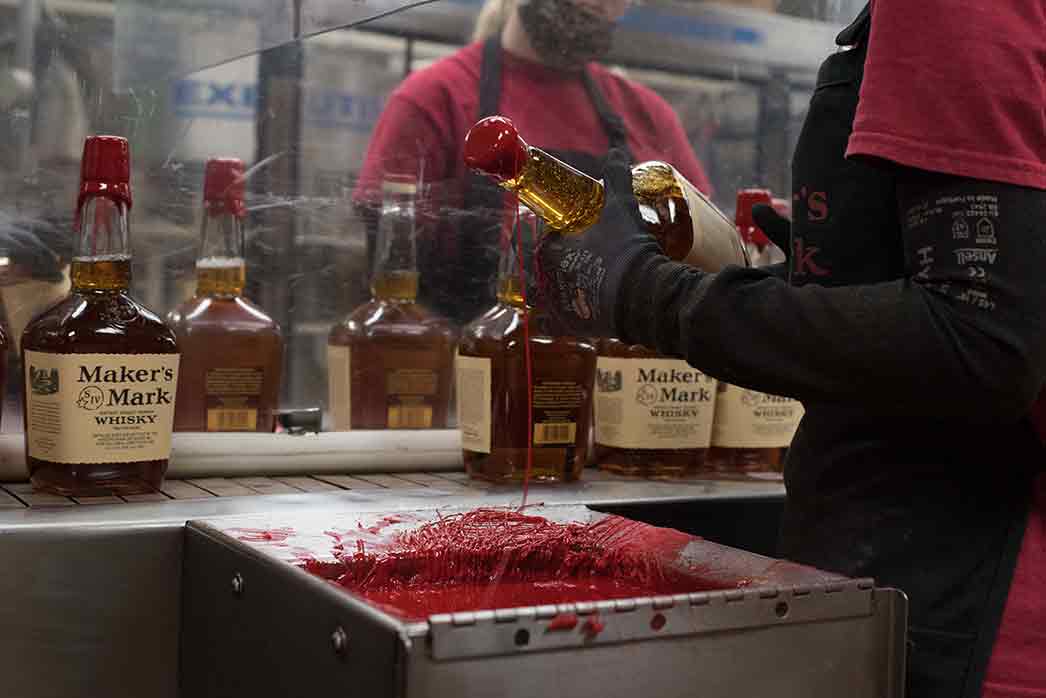

Loretto | Kentucky
THE SAMUEL FAMILY’S FEELINGS FOR BOURBON
”Don’t ruin the whiskey!” was Bill Samuel’s Sr. word to his son when he took over running the family business. Samuels Sr. had already burned the family’s 170-year-old whiskey recipe as he set about refining the flavour, before wife Marjorie transformed the bottle with its signature red wax topper. Meet the Maker’s Mark family, eight generations of creative Kentucky distillers.
Words and photos by Simon Urwin
The words Kentucky and bourbon go together like mac and cheese, ham and eggs, and the Stars and Stripes,” says Bill Samuels Jr. as he welcomes me to the Maker’s Mark distillery in the small community of Loretto, KY, population: 771. “They always have, they always will. This is the spiritual home of bourbon whiskey after all.”
Samuels – chairman emeritus of Maker’s Mark and nicknamed ‘the godfather of bourbon’ – then invites me on a tour of the distillery, first passing by an old painting of Daniel Boone, the explorer and pioneer who in the late 18th century blazed a trail through the Cumberland Gap into what is now Kentucky, where he established one of the first English-speaking settlements west of the Appalachian Mountains.

Settlers from Scotland and Ireland
“Without Daniel Boone, I guess we might not have Kentucky bourbon,” Samuels says with a smile. “The route he opened up lead to a flood of immigrants – mainly from Scotland and Ireland. They brought their distilling and drinking culture to the New World and they found the perfect conditions for making bourbon here. By the late 1700s and early 1800s some of Kentucky’s most famous distilling names had put down roots in the region – including my own ancestor, Robert Samuels, a Scot; I’m his five-times grandson. Nowadays, around 95% of all bourbon made in the United States, including Maker’s Mark, is made in the Bluegrass State.”
Perfect conditions
We skirt a stream that runs through the property. “One very important factor made those early distillers stay here of all places,” says Samuels, nodding towards the water. “Yes, there was fertile farmland for growing corn (bourbon’s principal ingredient) and plenty of wood for making barrels or burning as firewood during the distillation process – just like lots of other parts of the US. But water was the special magic ingredient; it made the whiskey taste better than anywhere else.”


Bourbon’s magic ingredient is specifically pure spring water filtered by limestone. Rich in minerals and extremely porous, the limestone allows water to pass through it freely; it absorbs calcium and magnesium in the process, and, crucially, eradicates impurities such as iron. “There’s never been a good bourbon made from soft water,” says Samuels. “And Kentucky water is the hardest in the country. To get an idea of what it’d be like if there was iron present, just dip a rusty nail into a glass of whiskey and you’ll see what it does to the flavour. It’ll turn your stomach.”
Old yeast
Samuels leads the way into the fermentation room, where Maker’s Mark’s unique recipe of milled grains – known as the mash bill – is fermented with yeast and water in vast cypress-wood tanks. “Cypress is ideal because it has no impact on flavour,” says Samuels as we watch the pungent slurry puttering merrily. “The yeast is an heirloom strain more than a hundred years old that has been passed down to every bottle of Maker’s Mark. It loves the magnesium in the water.”
Samuels goes on to explain that as per Federal rules, for a whiskey to qualify as a bourbon, the mash bill must consist of at least 51% corn; the remainder can be quantities of other small grains chosen by the distiller. Adding rye – a common bourbon ingredient – gives peppery, spicy notes, while barley results in more chocolatey flavours. Maker’s Mark eschews both in favour of red winter wheat.

The sweet red winter wheat
“It was an unusual choice and it all came about as a result of baking bread,” says Samuels. “Back in the 1950s, my father – Bill Snr – decided to play around with the family’s trusted 170-year-old bourbon recipe by experimenting with different flavouring grains. To save years of aging time, he baked several loaves with different combinations instead of distilling them. It led him to swap out the traditional rye for red winter wheat which gives the bourbon a sweetness, a lightness, that makes it really easy to drink.”
After fermentation and distillation is complete, the bourbon is barrel-aged in one of the rickhouses that are set in fields surrounding the distillery. Samuels takes me to one of them which is piled to the rafters with wooden barrels carrying liquid cargo, each one weighing 250kg. There he tells me that Federal rules dictate that while other whiskeys can be aged in barrels that previously held port or wine, all bourbon barrels must be made of new, unadulterated oak.
“We use American white oak, a Kentucky native”, he says. “It doesn’t have any of the strong-tasting saps or resins found in other woods. We season ours for a year outdoors which helps remove the bitter tannins too.” As per the regulations, the interior staves of the oak barrel must also be charred – to one of four different levels -depending on the flavour profile the distiller wants their bourbon to acquire. “Forty seconds of fire is all it takes to achieve a number three char which is our preference,” says Samuels. “It caramelizes the natural wood sugars and helps give the bourbon lovely vanilla notes.”

Colour and flavour
We climb the stairs to the top floor of the rickhouse, the warm air filled with a sweet, fruity aroma that resembles a slice of sherry-soaked fruit cake at Christmas. “Barrels spend a minimum of three hot Kentucky summers here so that the whiskey expands through the wood, gaining colour and flavour from the oak and char,” says Samuels. “It’s like making good porridge – you do the aggressive part of the cooking first and then you let it simmer down.”
As the climate and temperature can vary wildly from year to year, Samuels and the distillery tasting panel do a lot of sampling to keep a close eye on the aging process. “The goal is consistency, and that’s difficult when God gives you challenges with the weather every day. So, we taste regularly, then determine when the whiskey is ready to be hand rotated to a cooler section to keep it from maturing too quickly. Ultimately, we age for taste not time, and overall, it takes around six years. If we could make Bourbon any faster, we certainly wouldn’t.”
Our final stop is the plant where each Maker’s Mark bottle receives its signature crown of hand-dipped wax. “That was my mom’s idea”, Samuels says, as a procession of amber-filled bottles races along the conveyer belt – before being plunged head-first into vats of molten wax, the scarlet-coloured tears spilling down each bottle neck in their own unique pattern.
Mrs. Samuels made it look beautiful
“Mom (Marjorie Mattingly Samuels) was a biochemist, so she knew how to formulate the wax to achieve the right viscosity and colour,” he says. “Her laboratory wasn’t anything fancy. She used the deep fat fryer in the family kitchen to work it all out.”
Marjorie Samuels was also responsible for the aesthetic of the rest of the bottle beneath the topper. “The flavour stood out from the crowd, so she wanted the bottle to do the same on the store shelves. She was bored by the look of everything else on the market, so the distinctive square-shaped body was her idea; it was inspired by her collection of 19th-century cognac bottles. She loved calligraphy too. That led to the distinctive label which is still hand-cut to this day.”
Mrs. Samuels, an authority on 18th-century English pewter, even dreamed up the brand name – a nod to the maker’s marks that pewterers stamped on their works as proof of the purity and the provenance of the object in hand. “Up until then, whisky bottles all looked the same because they were designed solely by men. Mom didn’t have all the baggage of knowing how it should be done. We’re pretty sure it’s the first liquor bottle designed and named by a woman anywhere in the world”, he adds. “That’s what makes it so unique. Dad was in charge of making the contents taste great, but mom made it look really beautiful.”







